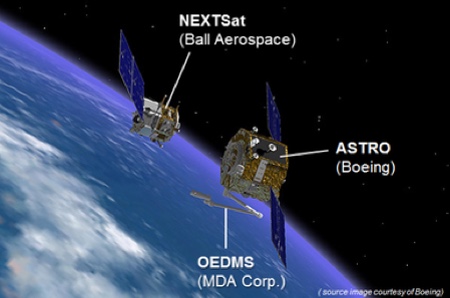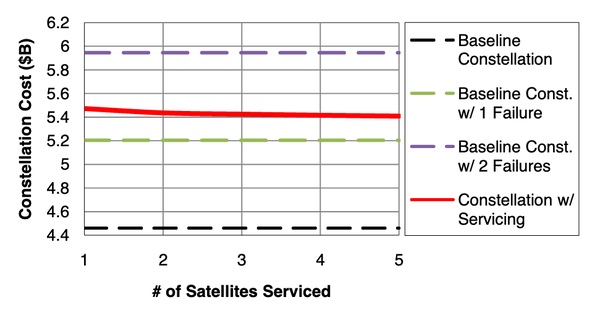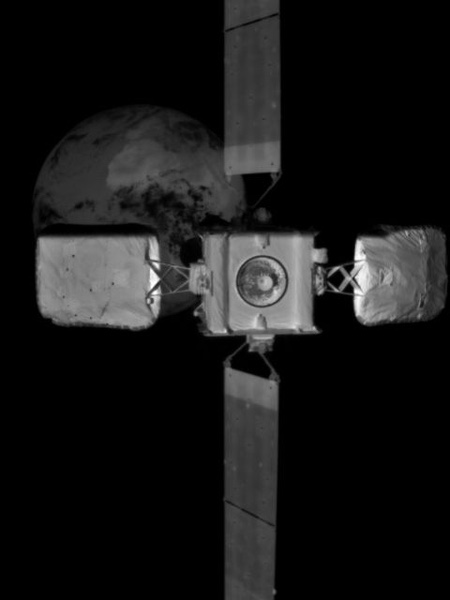To catch a star: the technical and geopolitical arguments for autonomous on-orbit satellite servicingby Matthew Jenkins
|
| The AFRL study showed that if a constellation had at least two serviceable failures, a servicing satellite would be beneficial to reduce overall costs. |
There have been numerous attempts at servicing missions over the years. In January 2003 and 2005 respectively, the United States Air Force launched Experimental Spacecraft Systems XSS-10, and XSS-11. Both satellites which demonstrated autonomous orbit matching woth other objects, a key technology needed for servicing.[1]
In 2005, NASA launched Demonstration of Autonomous Rendezvous Technology (DART). It was meant to test a number of technologies, including orbit matching and rendezvousing. DART unfortunately collided with the satellite it was meant to rendezvous with because of a sensor malfunction.[2]
In 2007, DARPA funded a Boeing mission called Orbital Express, which successfully demonstrated “a safe and cost-effective approach to autonomously service satellites in orbit.”[3] The mission consisted of two vehicles. The first was Autonomous Space Transport Robotic Operations (ASTRO), which released and grabbed a prototype serviceable satellite called NextSat, built by Ball Aerospace, in a series of experiments replacing both fuel and satellite components.
 An illustration of Orbital Express, highlighting component manufacturers. (credit: Boeing) |
Finally, a little more than a year ago, Northrop Grumman’s MEV-1 successfully docked with Intelsat 901 in February 2020. MEV-1 docked with IS-901 outside of the its geostationary (GEO) orbital slot, while MEV-2 was the first satellite to dock and service a satellite in its GEO orbital location.
The logical question to ask then, is it worth it? While space is certainly littered with debris that we can, at the present time, do nothing to obviate, the thought of extending the life of satellites is an exciting one. Satellites in low Earth orbit (LEO), which require frequent maneuvers to counteract Earth’s atmospheric drag, could be extended indefinitely. Additionally, sensors that require cryogenics to be operational could last longer, providing increased operational capability and decreasing the need for replenishment.
The Air Force Research Laboratory (AFRL) conducted a study in 2009 into on-orbit servicing and its potential cost benefits.[4] The study focused both on LEO and GEO spacecraft. The results suggest that on-orbit servicing of one satellite alone is not cost effective. This seems logical as the cost to launch a servicing satellite would be approximately the same as the satellite it is launched to service. The benefit really came into play when the model serviced a constellation of satellites. It showed that if a constellation had at least two serviceable failures, a servicing satellite would be beneficial to reduce overall costs. Logically, if you need to build and launch multiple satellites to replenish the failed ones, the math works out. This argument is stronger for GEO systems, as the cost to orbit is substantially higher.
 AFRL cost-effectiveness of on-orbit servicing |
As the space industry begins to more concertedly focus on disaggregated small satellites, the potential for on-orbit servicing seems like a cost-effective way to support sustaining the capabilities those constellations would provide. Imagine the potential for Starlink and SpaceX, and other, similar systems, if the massive constellation didn’t require replenishment! However, on orbit servicing presents some geopolitical challenges moving forward that will require a more comprehensive approach to answer.
First, approaching and manipulating satellites will undoubtedly invoke strong feelings from other spacefaring nations. If it can be used for innocuous purposes, it can also be used for nefarious ones. Advocates of satellites servicing have to think carefully about messaging and dealing with the real threat that other states will follow suit. What standards of conduct should be defined for RPO that would help ensure confidence in allies and foes alike that what the system is advertised to is all that it will do?
| There is little doubt that on-orbit servicing offers immense potential. However, technical and geopolitical considerations exist that require some answers before the United States, or any state, should embrace it outright. |
This is not a military problem. It is a state problem, and one that will bear increasingly more weight as other states look to achieve similar operations. Today we use the Registration Convention to describe a system’s “primary” purpose. Perhaps it should be amended to include all purposes it will serve. Obviously, this assumes transparency, something most states struggle with. Even still, this could go a long way in alleviating the anxiety a system whose primary mission is RPO would create.
Second, if any state seeks to enable RPO systems as a primary means of operation, it is logical to assume that the RPO satellites would become high-value assets (HVAs). While a shooting war in space seems unlikely, HVAs should, and do, get special consideration. Yet, the logical question becomes if the HVA was not available, could the other systems continue to conduct their primary mission? Obviously, when you create a dependency, a degree of autonomy is lost. Care must be given in balancing the costs of protecting the HVA and the costs of replacing the systems it services.
There is little doubt that on-orbit servicing offers immense potential. However, technical and geopolitical considerations exist that require some answers before the United States, or any state, should embrace it outright. Technically it’s been proven it can be done, but several questions remain. First, where is the logical breakeven point? How many servicing satellites are needed for a particular constellation? Geopolitically the questions are a little less tangible. What are the implications of a singularly RPO mission system? If the United States endorses it, we should expect others states to follow suit. This logically leads to a requirement for a more robust conversation on normative space behavior to include transparency and confidence building measures. While there has been little success in this arena to date, autonomous on-orbit servicing of satellites may just provide the impetus needed to force a hard conversation within the United Nations, or outside of it, on how the world gets comfortable with catching stars.
Endnotes
- “On-Orbit Satellite Servicing Study Project report,” National Aeronautics and Space Administration, Goddard Space Flight Center, Goddard Space Flight Center, October 2010.
- Ibid
- Boeing. “Orbital Express” (via Wayback Machine)
- T. Rexius, “Cost Effectiveness of On-Orbit Servicing,” Air Force Research Laboratory, Technical Paper AFRL-RZ-ED-TP-2009-270, June 2009.
- Ibid.
Note: we are using a new commenting system, which may require you to create a new account.
